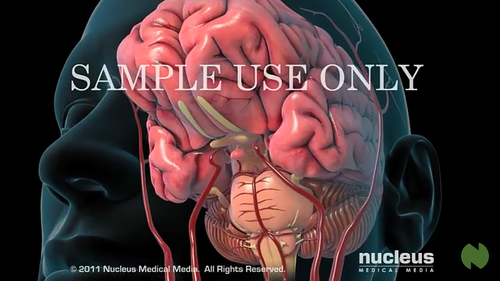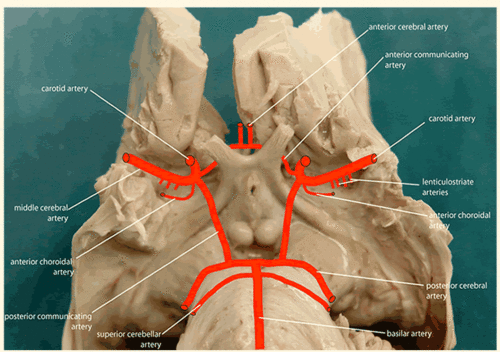Hemorrhagic Stroke: Intracerebral Hemorrhage: Difference between revisions
No edit summary |
No edit summary |
||
| Line 9: | Line 9: | ||
</div> | </div> | ||
== Introduction == | == Introduction == | ||
[[File:Stroke | [[File:Stroke pic.png|right|frameless|500x500px]] | ||
15% of acute strokes are hemorrhagic strokes which are caused by bursting of a blood vessel i.e. acute hemorrhage. There are two main types of hemorrhagic strokes, intracerebral hemorrhage (ICH) and subarachnoid hemorrhage which accounts for about 5% of all strokes. This page is about ICH ie bleeding within the brain tissue itself — a life-threatening type of stroke. A stroke occurs when the brain is deprived of oxygen and blood supply<ref>Tadi P, Lui F. [https://www.ncbi.nlm.nih.gov/books/NBK535369/ Acute Stroke (Cerebrovascular Accident)]. Available from: https://www.ncbi.nlm.nih.gov/books/NBK535369/ (last accessed 31.12.2019)</ref>. The image is od an ischaemic stroke (L) and Haemorrhagic stroke (R) | 15% of acute strokes are hemorrhagic strokes which are caused by bursting of a blood vessel i.e. acute hemorrhage. There are two main types of hemorrhagic strokes, intracerebral hemorrhage (ICH) and subarachnoid hemorrhage which accounts for about 5% of all strokes. This page is about ICH ie bleeding within the brain tissue itself — a life-threatening type of stroke. A stroke occurs when the brain is deprived of oxygen and blood supply<ref>Tadi P, Lui F. [https://www.ncbi.nlm.nih.gov/books/NBK535369/ Acute Stroke (Cerebrovascular Accident)]. Available from: https://www.ncbi.nlm.nih.gov/books/NBK535369/ (last accessed 31.12.2019)</ref>. The image is od an ischaemic stroke (L) and Haemorrhagic stroke (R) | ||
* Intracerebral hemorrhage (ICH) is a devastating event, carrying a very high morbidity and mortality rate that have not changed over the last 30 years. | * Intracerebral hemorrhage (ICH) is a devastating event, carrying a very high morbidity and mortality rate that have not changed over the last 30 years. | ||
Revision as of 08:07, 31 December 2019
This article or area is currently under construction and may only be partially complete. Please come back soon to see the finished work! (31/12/2019)
Original Editor - Your name will be added here if you created the original content for this page.
Lead Editors
Introduction[edit | edit source]
15% of acute strokes are hemorrhagic strokes which are caused by bursting of a blood vessel i.e. acute hemorrhage. There are two main types of hemorrhagic strokes, intracerebral hemorrhage (ICH) and subarachnoid hemorrhage which accounts for about 5% of all strokes. This page is about ICH ie bleeding within the brain tissue itself — a life-threatening type of stroke. A stroke occurs when the brain is deprived of oxygen and blood supply[1]. The image is od an ischaemic stroke (L) and Haemorrhagic stroke (R)
- Intracerebral hemorrhage (ICH) is a devastating event, carrying a very high morbidity and mortality rate that have not changed over the last 30 years.
- Hypertension and age-related amyloid angiopathy are the strongest risk factors for ICH, but smoking, anticoagulation with warfarin, excessive alcohol intake and cocaine also increase risk.[2]
- At one year, mortality ranges from 51% to 65% depending on the location of the hemorrhage. Half of these deaths occur in the first two days and at six months, only 20% of patients are expected to be independent.
- The incidence of hemorrhage increases exponentially with age and is higher in men than in women[2].
Clinically Relevant Anatomy[edit | edit source]
ICH are almost invariably associated with hypertension and are presumed by many to be the result of weakening of arterial walls by the trauma of an excessive pulse pressure. The most common sites of involvement are:
(1) the region of the putamen-external capsule in the distribution of the lenticulostriate branches of the middle cerebral artery (50%);
(2) the thalamus in the distribution of the small penetrating vessels from the posterior cerebral and posterior communicating arteries (10%);
(3) the cerebellum in the distribution of the deep penetrating branches of the superior cerebellar artery (10%); and
(4) the pons in the distribution of the paramedian branches of the basilar artery (10%).
The remaining 20% occur into the white matter of various lobes of the cerebral hemispheres.[3]
Mechanism of Injury / Pathological Process[edit | edit source]
- Hypertensive vascular change - ICH is usually caused by ruptured vessels that are degenerated due to long-standing hypertension the arteries showing prominent degeneration of the media and smooth muscles. Less frequently fibrinoid necrosis of the sub-endothelium with micro-aneurysms and focal dilatations may occur.
- Cerebral amyloid angiopathy - CAA is characterized by the deposition of amyloid-β peptide at capillaries, arterioles, and small- and medium-sized arteries in the cerebral cortex, leptomeninges, and cerebellum . CAA in the cerebral small vessel leads to sporadic ICH in elderly people, commonly associated with variations in the gene encoding apolipoprotein E epsilon 2 and 4 in chromosome 19 . Duplication of the APP locus on chromosome 21 is also found in families with familial early-onset Alzheimer disease and CAA. CAA-related ICHs occur mainly in the elderly subjects while a rare familial syndrome may manifest in relatively young patients.
- Molecular pathophysiology - The initial injury mechanism in ICH is compressing brain parenchyma by hematoma’s mass effect, resulting in physical disruption of parenchymal architecture.[4]
In aging individuals, and especially in those with Alzheimer's Disease, amyloid deposition may occur in the penetrating cortical vessels, making the vessels more friable and subject to hemorrhage. Typically, the hemorrhage is lobar (i.e., immediately subcortical) and the likelihood that amyloid angiopathy is the etiology of the hemorrhage is increased if there is no past history of hypertension.[3]
Risk Factors[edit | edit source]
Risk factors of intracerebral hemorrhage[4]
| Modifiable risk factors |
| Hypertension |
| Current smoking |
| Excessive alcohol consumption |
| Decreased Low-density lipoprotein cholesterol, low triglycerides |
| Anticoagulation |
| Use the antiplatelet agent |
| Sympathomimetic drugs (Cocaine, heroin, amphetamine, PPA and ephedrine) |
| Non-modifiable risk factor |
| Old age |
| Male sex |
| Asian ethnicity |
| Cerebral amyloid angiopathy |
| Cerebral microbleeds |
| Chronic kidney disease |
| Other factors suggested to be related the risk |
| Multi-parity |
| Poor working conditions (blue-collar occupation, longer working time) |
Clinical Presentation[edit | edit source]
add text here relating to the clinical presentation of the condition
Diagnostic Procedures[edit | edit source]
add text here relating to diagnostic tests for the condition
Outcome Measures[edit | edit source]
add links to outcome measures here (see Outcome Measures Database)
Management / Interventions[edit | edit source]
add text here relating to management approaches to the condition
Differential Diagnosis[edit | edit source]
add text here relating to the differential diagnosis of this condition
Resources[edit | edit source]
add appropriate resources here
References[edit | edit source]
- ↑ Tadi P, Lui F. Acute Stroke (Cerebrovascular Accident). Available from: https://www.ncbi.nlm.nih.gov/books/NBK535369/ (last accessed 31.12.2019)
- ↑ 2.0 2.1 Rymer MM. Hemorrhagic stroke: intracerebral hemorrhage. Missouri medicine. 2011 Jan;108(1):50.Available from:https://www.ncbi.nlm.nih.gov/pmc/articles/PMC6188453/ (last accessed 31.12.2019)
- ↑ 3.0 3.1 DISORDERS OF THE NERVOUS SYSTEM - REEVES & SWENSON Chapter 27. Cerebrovascular disorders Available from:https://www.dartmouth.edu/~dons/part_3/chapter_27.html#chpt_27_ICH (last accessed 31.12.2019)
- ↑ 4.0 4.1 An SJ, Kim TJ, Yoon BW. Epidemiology, risk factors, and clinical features of intracerebral hemorrhage: an update. Journal of stroke. 2017 Jan;19(1):3. Available from:https://www.ncbi.nlm.nih.gov/pmc/articles/PMC5307940/ (last accessed 31.12.2019)








